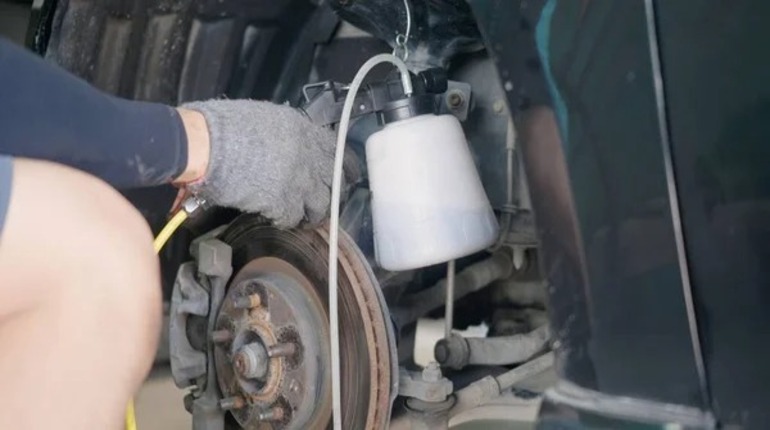ABS, or Anti-lock Braking System, sensors play a critical role in modern vehicle safety. These sensors contribute to preventing wheel lock-up during braking, enhancing control and stability. In this guide, we’ll delve into the function, importance, and maintenance of ABS sensors and brake system for auto.
The anti-lock braking system (ABS) in your vehicle is an essential part of maintaining safe driving, particularly in emergency braking situations. To protect both themselves and other drivers on the road, all automobile owners must be aware of the signs of an ABS sensor problem.
How ABS sensor works
It’s important to understand how the ABS sensor functions before digging into the signs of malfunction. The sensor is usually found at each wheel hub or axle and is also referred to as the wheel speed sensor. Its main job is to keep an eye on wheel speed and relay that information to the ABS control module.
The ABS control module uses sensor data to identify which wheel is about to lock up when you apply the brakes. It maintains steering control by modulating braking pressure to the wheel in question if it senses a wheel lock. This process happens fast and continuously until the vehicle comes to a stop, preventing skidding and loss of control. Understanding the role of ABS sensors and correcting problems in a timely manner helps maintain optimum braking performance and vehicle safety.
The ABS sensor is essential to the system’s proper operation. Without it, the system’s capacity to reliably detect fluctuations in wheel speed would be compromised, making it more difficult to prevent wheel lockup during braking. Longer stopping distances and a higher chance of collisions could result from this, particularly when braking suddenly or in slick conditions.
Common symptoms of ABS sensor malfunction
- ABS Light Illumination: The dashboard’s ABS warning light turning on is one of the most obvious indicators that an ABS sensor isn’t working properly. This light typically indicates a malfunctioning ABS system, including malfunctioning sensors. It is imperative to have the system inspected as soon as possible if the light remains on after starting the car or turns on while you are driving.
- Abnormal Brake Pedal Behavior: Abnormal brake pedal behavior may be the result of an ABS sensor that isn’t working properly. When exerting pressure, the brake pedal may feel particularly strong, soft, or spongy. When braking, the pedal occasionally pulses or vibrates irregularly, which could be a sign of an ABS sensor problem.
- Pulsating Feeling While Braking: When braking, you may experience a pulsating sensation via the steering wheel or brake pedal, in addition to strange brake pedal behavior. Usually when the ABS engages to prevent wheel locking, this pulse happens. But if it occurs frequently or irregularly, there may be a problem with the ABS sensor or another part of the system.
- Extended Stopping Distances: Especially on slick or uneven ground, a malfunctioning ABS sensor may also cause longer stopping distances. If you apply the brakes hard and observe that your car takes longer to stop than usual, there may be a problem with the ABS, including the sensors.
Understanding the brake system in your car is essential for both safety and overall vehicle maintenance. The brake pedal is the driver’s interface with the brake system. When pressed, it initiates the braking process. Connected to the brake pedal, the master cylinder converts the force from the pedal into hydraulic pressure.
Brake fluid is a vital component, transferring hydraulic pressure to the brake components. Regular checks and fluid replacement are crucial. Hydraulic brake lines carry brake fluid from the master cylinder to the brake calipers.
Most modern cars feature disc brakes, where brake pads clamp onto a rotating disc attached to the wheel. Older vehicles and some budget models still use drum brakes, where brake shoes press against the inside of a drum.
When to seek professional help
Examine the Brake System: Look for any overt indications of wear or damage, such as broken wires or connectors close to the wheel hubs. Make sure that the connectors for the ABS sensor are corrosion-free and firmly fastened.
Consult an Expert: It’s advisable to get help from a trained mechanic or automobile specialist if you can’t figure out the issue or if the symptoms continue. With the use of specialist diagnostic equipment, they can easily identify the problem and, if necessary, replace or repair the malfunctioning ABS sensor.
While do-it-yourselfers can fix some minor ABS sensor problems, it’s important to know when to call a professional. It is advisable to delegate the diagnosis and repair to qualified professionals if you are uncertain about the severity of the issue or do not have the required equipment and knowledge. Furthermore, a malfunctioning ABS sensor can jeopardize your car’s safety, therefore it’s critical to fix any problems right away to guarantee safe driving.
Regular brake fluid flushes prevent brake fluid contamination and maintain the efficiency of the hydraulic system. Follow your vehicle manufacturer’s recommendations, and check information about brake system symptoms from autodoc.co.uk, but the general recommendation is to check the brake system and ABS sensors of the car every two years. Professional mechanics conduct comprehensive brake inspections to identify issues. From replacing brake pads to addressing hydraulic system problems, professionals ensure the entire brake system functions optimally.
Finally
For every car owner, knowing the signs of an ABS sensor breakdown is essential. You can contribute to preserving the functionality and safety of your car’s ABS system by being aware of these indicators and acting quickly when needed. Always keep in mind that when it comes to auto maintenance and repairs, safety should come first.






